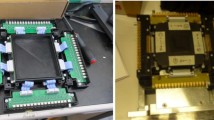Abstract
When a negatively charged muon stopped in a material, muonic atom, which has one muon in place of an electron in the atomic system, is formed. After muon deexcitation process with muonic X-ray emission, the muon reaches to the muonic 1 s state, and the muon is absorbed in the nucleus. As a result, highly excited nucleus is produced, and the nucleus emits neutrons and gamma-rays. In this work, we determined elemental depth profiling of gold concentrations on archeological sample, an old Japanese coin, by measuring gamma-ray intensities emitted from activated nucleus with various incident muon energies.




Similar content being viewed by others
References
Vasilopoulou T, Stamatelatos IE, Montoya EH, Bedregal PS, Tsalafoutas I, Bode P (2015) Large sample neutron activation analysis of irregular-shaped pottery artifacts. J Radioanal Nucl Chem 303:853–858
Shirai N, Hidaka Y, Yamaguchi A, Sekimoto S, Ebihara M, Kojima H (2015) Neutron activation analysis of iron meteorites. J Radioanal Nucl Chem 303:1375–1380
Hevesy G, Levi H (1936) Action of slow neutrons on rare earth elements. Nature 137:185
Révay Z (2009) Determining elemental composition using prompt γ activation analysis. Anal Chem 81:6851–6859
Ahmed MR, Al-Najjar S, Al-Amili MA, Al-Assafi N, Rammo N, Demidov AM, Govor LI, Cherepantsev YK (1978) Atlas of gamma-ray spectra from the inelastic scattering of reactor fast neutrons. Atomizdat, Moscow
Lutz GJ (1971) Photon activation analysis—a review. Anal Chem 43:93–103
Engfer R, Schneuwly H, Vuilleumier JL, Walter HK, Zehnder A (1974) Charge-distribution parameters, isotope shifts, isomer shifts, and magnetic hyperfine constants from muonic atoms. At Data Nucl Data Tables 14:509–597
Suzuki T, Measday DF, Roalsvig JP (1987) Total nuclear capture rates for negative muons. Phys Rev C 35:2212–2223
Measday DF (2001) The nuclear physics of muon capture. Phys Rep 354:243–409
Schneuwly H, Dubler T, Kaeser K, Robert-Tissot B, Schaller LA, Schellenberg L (1978) On the influence of the chemical bond on the relative muonic capture rates in elements of compounds. Phys Lett A 66:188–190
Backenstoss G, Charalambus S, Daniel H, Hamilton WD, Lynen U, Von Der Malsburg C, Poelz G, Povel HP (1971) Nuclear γ-rays following muon capture. Nucl Phys A 162:541–551
Ninomiya K, Ito TU, Higemoto W, Kita M, Shinohara A, Nagatomo T, Kubo MK, Strasser P, Kawamura N, Shimomura K, Miyake Y, Miura T (2011) Negative muon capture on nitrogen oxide molecules. J Korean Phys Soc 59:2917–2920
Yoshida G, Ninomiya K, Higemoto W, Ito TU, Nagatomo T, Strasser P, Kawamura N, Shimomura K, Miyake Y, Miura T, Kubo MK, Shinohara A (2015) Muon capture probability of carbon and oxygen for CO, CO2, and COS under low-pressure gas conditions. J Radioanal Nucl Chem 303:1277–1281
Kubo MK, Moriyama H, Tsuruoka Y, Sakamoto S, Koseto E, Saito T, Nishiyama K (2008) Non-destructive elemental depth-profiling with muonic X-rays. J Radioanal Nucl Chem 278:777–781
Ninomiya K, Nagatomo T, Kubo K, Ito TU, Higemoto W, Kita M, Shinohara A, Strasser P, Kawamura N, Shimomura K, Miyake Y, Saito T (2012) Development of nondestructive and quantitative elemental analysis method using calibration curve between muonic X-ray intensity and elemental composition in bronze. Bull Chem Soc Jpn 85:228–230
Ninomiya K, Kubo MK, Nagatomo T, Higemoto W, Ito TU, Kawamura N, Strasser P, Shimomura K, Miyake Y, Suzuki T, Kobayashi Y, Sakamoto S, Shinohara A, Saito T (2015) Nondestructive elemental depth-profiling analysis by muonic X-ray measurement. Anal Chem 87:4597–4600
Shimomura K, Koda A, Strasser P, Kawamura N, Fujimori H, Makimura S, Higemoto W, Nakahara K, Ishida K, Nishiyama K, Nagamine K, Miyake Y (2009) Superconducting muon channel at J-PARC. Nucl Instrum Methods Phys Res Sect A 600:192–194
Ueda M, Taguchi I, Saito T (1996) Non-destructive analysis of the fineness of Kobans in the Yedo Period, Discussion Paper 1996-E-26. Institute for Monetary and Economic Studies, Bank of Japan, Tokyo
Blachot J (2000) Nuclear data sheets for A = 108. Nucl Data Sheets 91:135–296
Singh B (2006) Nuclear data sheets for A = 194. Nucl Data Sheets 107:1531–1746
Xiaolong H (2007) Nuclear data sheets for A = 196. Nucl Data Sheets 108:1093–1286
Measday DF, Stocki TJ, Tam H (2007) γ rays from muon capture in I, Au and Bi. Phys Rev C 75:045501
Daniel H, Hartmann FJ, Naumann RA (1999) Solid-state effects on Coulomb capture and X-ray cascade of negative muons. Phys Rev A 59:3343–3348
Oshima M, Toh Y, Hatsukawa Y, Koizumi M, Kimura A, Haraga A, Ebihara M, Syshida K (2008) Multiple gamma-ray detection method and its application to nuclear chemistry. J Radioanal Nucl Chem 278:257–262
Acknowledgments
This research was supported by the Grant-in-Aid for Young Scientists B (JSPS KAKENHI, Japan: Grant Number 26800213).
Author information
Authors and Affiliations
Corresponding author
Rights and permissions
About this article
Cite this article
Ninomiya, K., Inagaki, M., Kubo, M.K. et al. Negative muon induced elemental analysis by muonic X-ray and prompt gamma-ray measurements. J Radioanal Nucl Chem 309, 65–69 (2016). https://doi.org/10.1007/s10967-016-4772-y
Received:
Published:
Issue Date:
DOI: https://doi.org/10.1007/s10967-016-4772-y




